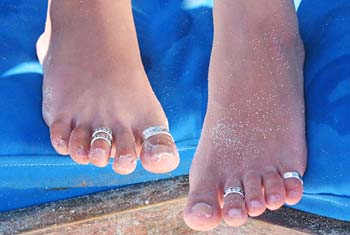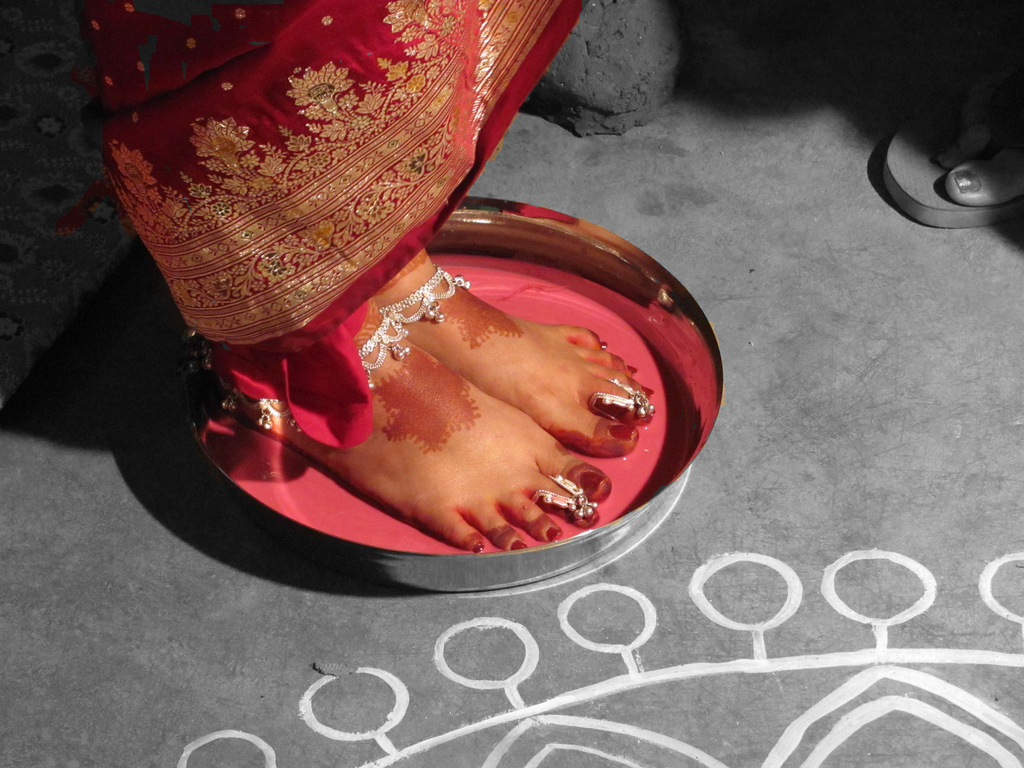Toe ring on:
[Wikipedia]
[Google]
[Amazon]
 A toe ring is a ring made out of
A toe ring is a ring made out of
 Toe rings in India are usually made of
Toe rings in India are usually made of
George Frederick Kunz page 80, Lippincott Co. Philadelphia, 1917
File:Anklet-ToeRing1.jpg, A toe ring with attached anklet.
File:ToeRingHavi.jpg, A toe ring being worn by a man.
 A toe ring is a ring made out of
A toe ring is a ring made out of metals
A metal () is a material that, when polished or fractured, shows a lustrous appearance, and conducts electricity and heat relatively well. These properties are all associated with having electrons available at the Fermi level, as against no ...
and non-metals worn on any of the toes. The second toe of either foot is where they are worn most commonly. This is because proportionately it is the longest toe and thus the easiest toe to put a ring on and stay without being connected to anything else. In most western countries they are a relatively new fashion
Fashion is a term used interchangeably to describe the creation of clothing, footwear, Fashion accessory, accessories, cosmetics, and jewellery of different cultural aesthetics and their mix and match into Clothing, outfits that depict distinct ...
accessory, and typically have no symbolic meaning. They are usually worn with barefoot sandals, anklets, bare feet or flip flops.
Like finger rings, toe rings come in many shapes and forms, from intricately designed flowers embedded with jewels to simple bands. Fitted toe rings are rings that are of one size, whereas adjustable toe rings have a gap at the bottom so they can be easily made to fit snugly.
Toe rings in India
The wearing of toe rings has been practised in India since ancient times. In theRamayana
The ''Ramayana'' (; ), also known as ''Valmiki Ramayana'', as traditionally attributed to Valmiki, is a smriti text (also described as a Sanskrit literature, Sanskrit Indian epic poetry, epic) from ancient India, one of the two important epics ...
, there is a mention of Sita, on being abducted by Ravana, throwing her toe ring down so that lord Rama could find her. Toe rings worn by a woman signify that she is married. In many different Indian cultures, the husband puts the toe rings on the second toe of both of the wife's feet during the wedding ceremony. It is worn as a symbol of the married state by Hindu
Hindus (; ; also known as Sanātanīs) are people who religiously adhere to Hinduism, also known by its endonym Sanātana Dharma. Jeffery D. Long (2007), A Vision for Hinduism, IB Tauris, , pp. 35–37 Historically, the term has also be ...
women and is called ''bichiya'' (pronounced: bee-chee-ya) in Hindi
Modern Standard Hindi (, ), commonly referred to as Hindi, is the Standard language, standardised variety of the Hindustani language written in the Devanagari script. It is an official language of India, official language of the Government ...
, ''minji'' (മിഞ്ചി) or ''kaalmothiram'' (കാൽമോതിരം) in Malayalam
Malayalam (; , ) is a Dravidian languages, Dravidian language spoken in the Indian state of Kerala and the union territories of Lakshadweep and Puducherry (union territory), Puducherry (Mahé district) by the Malayali people. It is one of ...
, Pāda Jhuṇtikā (ପାଦ ଝୁଣ୍ଟିକା) in Odia language
Odia (;"Odia"
''Lexico''. , ISO 15919, ISO: , ; formerly rendere ...
, ''jodavi'' (जोडवी) in Marathi, ''Mettelu'' (మెట్టెలు) in Telugu, ''Angot'' (আঙট/আংট্; pronounced: aa-nng-ot) in Bengali, ''Metti''/''Kanaiyazhi'' in Tamil (மெட்டி/கணையாழி), ''Kaalungura'' (ಕಾಲುಂಗುರಗಳು) in ''Lexico''. , ISO 15919, ISO: , ; formerly rendere ...
Kannada
Kannada () is a Dravidian language spoken predominantly in the state of Karnataka in southwestern India, and spoken by a minority of the population in all neighbouring states. It has 44 million native speakers, and is additionally a ...
.
 Toe rings in India are usually made of
Toe rings in India are usually made of silver
Silver is a chemical element; it has Symbol (chemistry), symbol Ag () and atomic number 47. A soft, whitish-gray, lustrous transition metal, it exhibits the highest electrical conductivity, thermal conductivity, and reflectivity of any metal. ...
and worn in pairs (unlike in Western countries, where they are worn singly or in unmatched pairs) on the second toe of both feet. Traditionally, they are quite ornate, though more contemporary designs are now being developed to cater to the modern bride. Some 'bichiya sets' may have pairs for four of the five toes, excluding the little pinky. 'Bichiyas' may not be made of gold
Gold is a chemical element; it has chemical symbol Au (from Latin ) and atomic number 79. In its pure form, it is a brightness, bright, slightly orange-yellow, dense, soft, malleable, and ductile metal. Chemically, gold is a transition metal ...
, as gold holds a 'respected' status and may not be worn below the waist by Hindus, but this is not followed very strictly and toe rings made of gold
Gold is a chemical element; it has chemical symbol Au (from Latin ) and atomic number 79. In its pure form, it is a brightness, bright, slightly orange-yellow, dense, soft, malleable, and ductile metal. Chemically, gold is a transition metal ...
and diamond
Diamond is a Allotropes of carbon, solid form of the element carbon with its atoms arranged in a crystal structure called diamond cubic. Diamond is tasteless, odourless, strong, brittle solid, colourless in pure form, a poor conductor of e ...
s are commonly seen.
Toe rings are believed to have other associated benefits according to Ayurveda
Ayurveda (; ) is an alternative medicine system with historical roots in the Indian subcontinent. It is heavily practised throughout India and Nepal, where as much as 80% of the population report using ayurveda. The theory and practice of ayur ...
. Toe rings have been believed to be worn to regulate the menstrual cycle
The menstrual cycle is a series of natural changes in hormone production and the structures of the uterus and ovaries of the female reproductive system that makes pregnancy possible. The ovarian cycle controls the production and release of eg ...
, and thus increase the chances of conception, as the slight pressure on the second toe ensures a healthy uterus. Some cultures also say that the pressure felt on the second toe helps to ease pain during intercourse. Unmarried Hindu girls may put toe rings on the third toe to help ease menstrual pain. Although there have been no scientific studies to verify these claims.
Toe rings are also worn by men in Tamil culture, usually in a simpler design for comfort. The practice of Tamil men wearing toe rings/Metti had a use in ancient times when people used to walk around barefoot. The toe ring was a way for women to identify married men as it was the norm for women to look down when walking.
In the 19th century, mirror rings (i.e. rings with a small used mirror placed on them) were sometimes worn on the great toe assumed to be for decorative purposes. Nowadays, toe rings are available in rubber and non-precious metals and are used for decorative purposes. Traditionally, a large ring was worn on the great toe of the left foot to indicate a married status. Some men frequently wore a ring on the big toe for curative purposes or to augment their masculine vigor. These rings were seldom closed circles but open hoops so that they could easily be removed.Rings for the Finger: Toe RingsGeorge Frederick Kunz page 80, Lippincott Co. Philadelphia, 1917
Toe rings outside India
Toe rings were introduced to the United States by ''Marjorie Borell'' who, after returning from India began manufacturing and selling them in New York in 1973. Her first retail outlet was Fiorucci, a trendy fashion retailer located on 59th Street in New York. The "''Original Toe Ring Boutique''" sold toe rings in silver, gold and with diamonds. She eventually sold them in Bloomingdale's and many other retail outlets but because her designs could not be patented, she moved on to other ventures but retains the title of Toe Ring Lady to this day. In the US, toe rings are worn by men and women alike. There is no particular significance of wearing a toe ring, but more of a fashion jewelry statement. Toe rings can be found at manystate fair
A state fair is an annual competitive and recreational gathering of a U.S. state's population, usually held in late summer or early fall. It is a larger version of a county fair, often including only exhibits or competitors that have won in t ...
booths and beach town shops around the country. Small boutiques in popular tourist locations often offer personal fittings of fitted rings, which can be worn year round. Often, the rings are fitted by spraying Windex on the toe, then sliding them on for a tight fit.
In Africa, toe rings are worn by male and females. It is believed that the tradition arrived to Africa from India.
Gallery
References
{{Jewellery Rings (jewellery) Toes